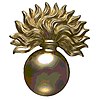1st Regiment of Footguards
| The Grenadier Guards | |
|---|---|

Cap Badge of The Grenadier Guards
|
|
| Active | 1656–present |
| Country |
(1660–1707) (1707–1800) (1801–present) |
| Allegiance | Elizabeth II |
| Branch |
|
| Type | Foot Guards |
| Role | 1st Battalion – Light Infantry Nijmegen Company – Public Duties |
| Size | One battalion One independent company |
| Part of | Guards Division |
| Garrison/HQ | RHQ – London 1st Battalion – Aldershot Nijmegen Company – London |
| Nickname(s) | The Bill Browns |
| Motto(s) |
"Honi soit qui mal y pense" (French) "evil be to him who evil thinks" |
| March | Quick: The British Grenadiers Slow: Scipio |
| Engagements | Waterloo |
| Commanders | |
| Colonel in Chief | Elizabeth II |
| Colonel of the Regiment | Prince Andrew, Duke of York |
| Insignia | |
| Tactical Recognition Flash |  |
| Plume | White Left side of Bearskin cap |
| Collar Badge | Grenade |
| Shoulder Badge | Royal Cipher |
| Abbreviation | GREN GDS |
The Grenadier Guards (GREN GDS) is an infantry regiment of the British Army. It is the most senior regiment of the Guards Division and, as such, is the most senior regiment of infantry. It is not, however, the most senior regiment of the Army, this position being attributed to The Life Guards. Although The Coldstream Guards were formed before The Grenadier Guards, the regiment is ranked after the Grenadiers in seniority as, having been a regiment of the New Model Army, the Coldstream served the Crown for four fewer years than the Grenadiers (the Grenadiers having formed as a Royalist regiment in exile in 1656 and the Coldstream having sworn allegiance to the Crown upon the Restoration in 1660).
The grouping of buttons on the tunic is a common way to distinguish among the regiments of Foot Guards. Grenadier Guards' buttons are equally spaced and embossed with the Royal Cypher reversed and interlaced surrounded by the Royal Garter bearing the royal motto Honi soit qui mal y pense (Evil be to him who evil thinks). Their white belt ("Buff Belt") with brass clasps also carry the Royal Cypher. Modern Grenadier Guardsmen wear a cap badge of a "grenade fired proper" with seventeen flames. This cap badge has to be cleaned twice a day – once in the morning, and once in the afternoon. A tarnished grenade is severely frowned upon and can be punished by disciplinary action within the Regiment.
The Grenadier Guards trace their lineage back to 1656, when Lord Wentworth's Regiment was raised in Bruges, in the Spanish Netherlands (present-day Flanders), from gentlemen of the Honourable Artillery Company by the then heir to the throne, Prince Charles (later King Charles II) where it formed a part of exiled King's bodyguard. A few years later, a similar regiment known as John Russell's Regiment of Guards was formed. In 1665, these two regiments were combined to form the 1st Regiment of Foot Guards, consisting of 24 companies of men. Since then the Grenadier Guards have served ten Kings and four Queens, including the current Queen Elizabeth II. Throughout the 18th century, the regiment took part in a number of campaigns including the War of Spanish Succession, the War of Austrian Succession and the Seven Years' War. At the end of the Napoleonic Wars, the regiment gained the name "Grenadier" in July 1815 following a Royal Proclamation.
...
Wikipedia
